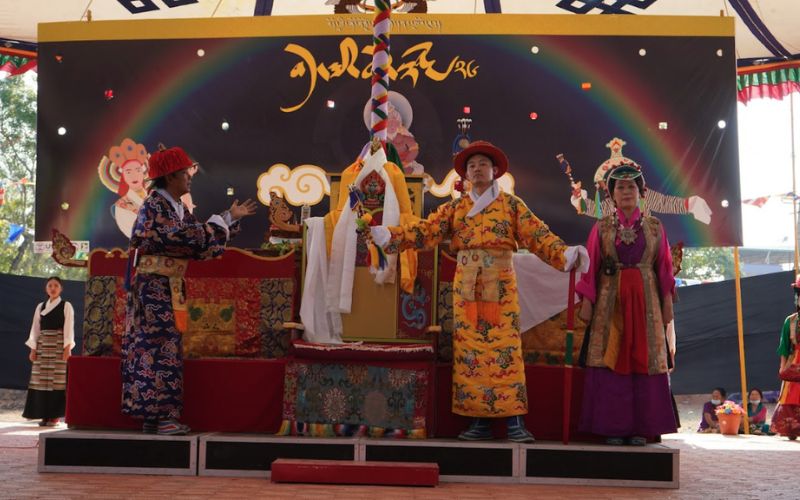
Tibet.net
On March 19th, the 26th Shoton Festival took place in Mundgod with Kundeling Tatsak Rinpoche serving as the main guest. The 10-day opera festival featured 11 troupes and was attended by roughly 2,000 individuals. During the event, Dhondup Tsering, the director of TIPA, recognized donors and former opera performers in his speech, emphasizing the significance of the Ache Lhamo tradition to the participants and audience.
The ancient Tibetan secular theater, Ache Lhamo, which has been performed for centuries, continues to thrive as a cultural treasure. This vibrant art form incorporates music, dance, and colorful masks, presenting narratives drawn from Buddhist folk tales, Tibetan history, and the lives of important figures. With its roots firmly planted in Tibetan culture and history, Lhamo has influenced similar traditions in other regions like Bhutan. The three unique schools of Lhamo, Kyimulunga, Gyangara, and Chungba, have helped to keep this theatrical form alive and well-preserved. Despite the passage of time, Lhamo continues to delight audiences with its distinctive blend of storytelling and performance art.
The 26th Shoton Festival saw the largest number of participants since its inception in 1993, and the day's significance was further enhanced by the 25th anniversary of the Mundgod Tibetan Opera Society. The monastic community and the general public also contributed to TIPA's efforts to preserve this centuries-old art in exile.
The event concluded with a performance by TIPA artists and a vote of appreciation proposed by assistant artistic director Tenzin Phuntsok. Chief guests Kundeling Tatsak Rinpoche and Tsering Wangmo, director and co-founder of Chaksampa, both made donations of one lakh Indian rupees each, while the Chaksampa contributed $1500 USD.
The term "Sho" means yogurt and "Ton" means banquet in Tibetan, so the phrase "Shoton" essentially refers to a yogurt banquet. During the festival, Tibetan artists arrange classical dances and folk music performances. Various performing arts groups can participate in the festivities, including professionals and TIPA students, creating a stunning display. Typically, the competition-oriented Ache Lhamo performances commence at NorbuLingka, Lhasa.
Apart from the performances by artists, monasteries also display large Buddha paintings or Thangkas during the festival. The festival's origin is rooted in the tradition of Buddhist monks returning from week-long retreats and receiving yogurt from the local people, and this aspect pays tribute to that history. The Drepung Monastery usually hosts this event, and it attracts a large number of Tibetans and foreign visitors who come to witness the extensive Buddha painting. This is a significant time for both local Tibetans and tourists.
The Shoton Festival celebrates the return of Buddhist monks from week-long retreats and involves various activities that showcase Tibetan culture and traditions. The festival kicks off with a Thangka exhibition at the Drepung Monastery where a large Maitreya Buddha is displayed and people offer white Hada offerings. After the exhibition, the locals and visitors move towards Norbulingka Park for a picnic and to enjoy the yogurt feast. Traditional Tibetan garbs are worn, tents are set up, and food and beverages are prepared for the celebration.
The highlight of the festival is the Tibetan Opera Performance, where professional and amateur performers showcase traditional dance techniques and perform Tibetan shows. The performances take place in Norbulingka Park and attract large crowds of families and friends who enjoy the festivities together. The festival also includes bonfires during the night, and the atmosphere is full of enjoyment and pleasure. Overall, the Shoton Festival is a significant time for both locals and visitors to immerse themselves in Tibetan culture and traditions.
Edited and collated by Team TRC